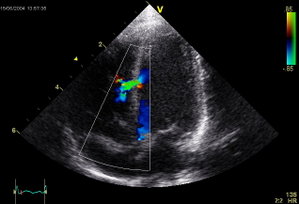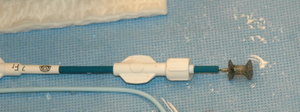Definition
A ventricular septal defect is a hole in the wall of the heart (septum) that separates the left lower chamber (left ventricle) from the right lower chamber (right ventricle). The hole allows blood to flow from the left ventricle to the right ventricle instead of entering the aorta for distribution throughout the body. Ventricular septal defect is one of a group of heart problems found in newborn babies that are collectively called congenital heart disease.
Description
The heart has four chambers. The two lower chambers are called ventricles and are responsible for pumping blood. The right ventricle pumps blood to the lungs and the left ventricle pumps blood throughout the body. If there is a hole in the septum that separates the two ventricles, blood from the left ventricle can enter the right ventricle. This blood recycles through the lungs before returning to the left ventricle. This results in less oxygenated blood reaching the body. If the hole is sufficiently large, the lack of oxygen being delivered to the body can cause severe problems, including heart failure and breathlessness. Approximately 0.7% of all babies have a congenital heart defect. Of these, 20% have a ventricular septal defect.
Causes & symptoms
Congenital heart defects are errors in the development of the heart structure. They occur early in the life of the embryo. There is no known cause of congenital heart defects. They can be associated with several diseases, such as German measles (rubella) and Down syndrome. Genetics does not seem to play a role in ventricular septal defect. People with a heart defect do not have an increased chance of passing it on to their children.
Symptoms result from a reduced amount of oxygen going to the body. Symptoms are proportional to the size of the defect. They may appear at any time in the life of the child. In cases where the hole in the septum is very small, few or no symptoms may appear and the child may develop normally. In cases where the ventricular septal defect is large, the newborn will shows signs of heavy breathing, sweating, and feeding difficulties. Children with this defect tire easily. Ventricular septal defect can also result in stunted growth resulting from insufficient oxygen being delivered to the growing body. Children with ventricular septal defect tend to suffer more frequent colds and pneumonia, and have a higher rate of inflammation and infection of the heart (endocarditis).
Diagnosis
The condition is first suspected based on observation of the child. The physician will listen to the heart with a stethoscope (auscultation) to detect a heart murmur. X rays, electrocardiogram (ECG), and echocardiography can all be used to evaluate ventricular septal defect.
Treatment
Most small holes close without treatment. Often, as the child grows, the hole closes or becomes smaller. If the hole is large or fails to close, the child is usually treated with drugs. Holes that persist and are causing problems in development are corrected by open heart surgery. Usually, surgery is performed after one year of age, but before the child enters school. This allows time for a trial of drug therapy, which could potentially eliminate the need for surgery. The operation is generally safe.
Prognosis
Children with small septal defects tend to develop normally and without any effect on their ability to participate in physical activities. Surgery allows children with larger defects to live nearly normal lives.
Key Terms
- Echocardiogram
- An image of the heart produced by an instrument that uses sound waves to create image the heart.
- Electrocardiogram
- A graph of the heart's beating action.
- Endocarditis
- An inflammation of the interior lining of the heart that is frequently caused by infectious agents.
Further Reading
For Your Information
Books
- Alexander, R.W., R. C. Schlant, and V. Fuster, eds. The Heart, 9th ed. New York: McGraw-Hill, 1998.
- Berkow, Robert, ed. Merck Manual of Medical Information. Whitehouse Station, NJ: Merck Research Laboratories, 1997.
Other
- Ventricular Septal Defect. Website: http://www.merck.com.
Gale Encyclopedia of Medicine. Gale Research, 1999.



